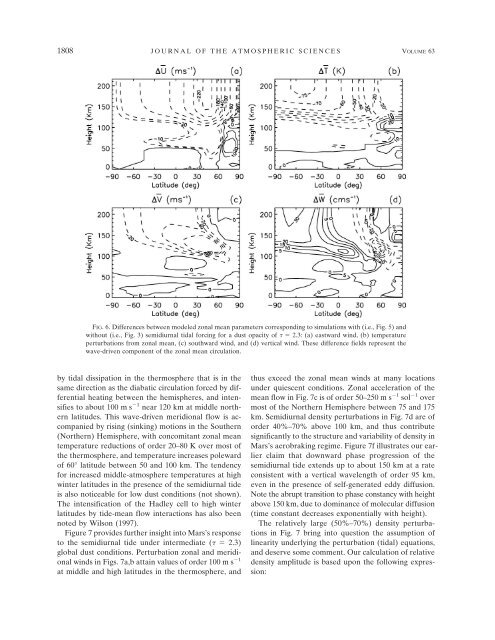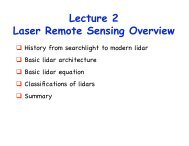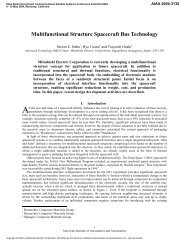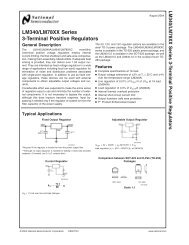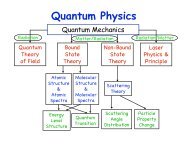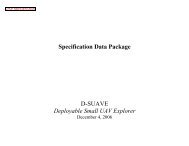Solar Semidiurnal Tide in the Dusty Atmosphere of Mars
Solar Semidiurnal Tide in the Dusty Atmosphere of Mars
Solar Semidiurnal Tide in the Dusty Atmosphere of Mars
- No tags were found...
Create successful ePaper yourself
Turn your PDF publications into a flip-book with our unique Google optimized e-Paper software.
1808 JOURNAL OF THE ATMOSPHERIC SCIENCES VOLUME 63FIG. 6. Differences between modeled zonal mean parameters correspond<strong>in</strong>g to simulations with (i.e., Fig. 5) andwithout (i.e., Fig. 3) semidiurnal tidal forc<strong>in</strong>g for a dust opacity <strong>of</strong> 2.3: (a) eastward w<strong>in</strong>d, (b) temperatureperturbations from zonal mean, (c) southward w<strong>in</strong>d, and (d) vertical w<strong>in</strong>d. These difference fields represent <strong>the</strong>wave-driven component <strong>of</strong> <strong>the</strong> zonal mean circulation.by tidal dissipation <strong>in</strong> <strong>the</strong> <strong>the</strong>rmosphere that is <strong>in</strong> <strong>the</strong>same direction as <strong>the</strong> diabatic circulation forced by differentialheat<strong>in</strong>g between <strong>the</strong> hemispheres, and <strong>in</strong>tensifiesto about 100 m s 1 near 120 km at middle nor<strong>the</strong>rnlatitudes. This wave-driven meridional flow is accompaniedby ris<strong>in</strong>g (s<strong>in</strong>k<strong>in</strong>g) motions <strong>in</strong> <strong>the</strong> Sou<strong>the</strong>rn(Nor<strong>the</strong>rn) Hemisphere, with concomitant zonal meantemperature reductions <strong>of</strong> order 20–80 K over most <strong>of</strong><strong>the</strong> <strong>the</strong>rmosphere, and temperature <strong>in</strong>creases poleward<strong>of</strong> 60° latitude between 50 and 100 km. The tendencyfor <strong>in</strong>creased middle-atmosphere temperatures at highw<strong>in</strong>ter latitudes <strong>in</strong> <strong>the</strong> presence <strong>of</strong> <strong>the</strong> semidiurnal tideis also noticeable for low dust conditions (not shown).The <strong>in</strong>tensification <strong>of</strong> <strong>the</strong> Hadley cell to high w<strong>in</strong>terlatitudes by tide-mean flow <strong>in</strong>teractions has also beennoted by Wilson (1997).Figure 7 provides fur<strong>the</strong>r <strong>in</strong>sight <strong>in</strong>to <strong>Mars</strong>’s responseto <strong>the</strong> semidiurnal tide under <strong>in</strong>termediate ( 2.3)global dust conditions. Perturbation zonal and meridionalw<strong>in</strong>ds <strong>in</strong> Figs. 7a,b atta<strong>in</strong> values <strong>of</strong> order 100 m s 1at middle and high latitudes <strong>in</strong> <strong>the</strong> <strong>the</strong>rmosphere, andthus exceed <strong>the</strong> zonal mean w<strong>in</strong>ds at many locationsunder quiescent conditions. Zonal acceleration <strong>of</strong> <strong>the</strong>mean flow <strong>in</strong> Fig. 7c is <strong>of</strong> order 50–250 m s 1 sol 1 overmost <strong>of</strong> <strong>the</strong> Nor<strong>the</strong>rn Hemisphere between 75 and 175km. <strong>Semidiurnal</strong> density perturbations <strong>in</strong> Fig. 7d are <strong>of</strong>order 40%–70% above 100 km, and thus contributesignificantly to <strong>the</strong> structure and variability <strong>of</strong> density <strong>in</strong><strong>Mars</strong>’s aerobrak<strong>in</strong>g regime. Figure 7f illustrates our earlierclaim that downward phase progression <strong>of</strong> <strong>the</strong>semidiurnal tide extends up to about 150 km at a rateconsistent with a vertical wavelength <strong>of</strong> order 95 km,even <strong>in</strong> <strong>the</strong> presence <strong>of</strong> self-generated eddy diffusion.Note <strong>the</strong> abrupt transition to phase constancy with heightabove 150 km, due to dom<strong>in</strong>ance <strong>of</strong> molecular diffusion(time constant decreases exponentially with height).The relatively large (50%–70%) density perturbations<strong>in</strong> Fig. 7 br<strong>in</strong>g <strong>in</strong>to question <strong>the</strong> assumption <strong>of</strong>l<strong>in</strong>earity underly<strong>in</strong>g <strong>the</strong> perturbation (tidal) equations,and deserve some comment. Our calculation <strong>of</strong> relativedensity amplitude is based upon <strong>the</strong> follow<strong>in</strong>g expression:


